Don't wanna be here? Send us removal request.
Video
youtube
The Cloud Gaming Market Revolutionizing the Future of Gaming #Cloud #Gam...
0 notes
Text
Navigating the Two Wheeler Logistics Market Revolutionizing Urban Mobility
Introduction: Embracing Change in Urban Mobility
In today's rapidly evolving urban landscape, efficient logistics solutions are essential for meeting the growing demand for last-mile delivery services. This article delves into the intricacies of the two wheeler logistics market, examining its evolution, challenges, and transformative impact on urban mobility.

Unpacking Two Wheeler Logistics
Defining Two Wheeler Logistics
Two wheeler logistics involve the use of motorcycles, scooters, and bicycles for transporting goods and parcels within urban environments, particularly for last-mile delivery operations. These agile and cost-effective vehicles offer a versatile alternative to traditional delivery vans and trucks, enabling faster and more efficient distribution of goods in congested urban areas.
Key Components of Two Wheeler Logistics
Fleet Management Systems: Advanced fleet management systems leverage GPS tracking, route optimization, and real-time monitoring to streamline two wheeler logistics operations, improve delivery accuracy, and minimize transit times.
Delivery Platforms: Digital delivery platforms connect retailers, e-commerce companies, and logistics providers with a network of two wheeler riders, facilitating on-demand delivery services, order management, and customer communications.
Safety and Compliance: Safety regulations, rider training programs, and compliance standards are integral to two wheeler logistics, ensuring rider safety, adherence to traffic laws, and responsible handling of goods during transit.
Market Trends and Growth Drivers
Rise of E-Commerce and On-Demand Services
The proliferation of e-commerce platforms and on-demand delivery services has fueled the demand for two wheeler logistics solutions, as retailers and consumers seek faster, more cost-effective delivery options for online purchases and perishable goods.
Urbanization and Traffic Congestion
Urbanization trends and increasing traffic congestion in metropolitan areas have created challenges for traditional delivery vehicles, prompting logistics providers to explore alternative modes of transportation such as motorcycles and scooters for agile and efficient last-mile deliveries.
Applications and Use Cases
Food Delivery Services
Two wheeler logistics play a vital role in food delivery services, enabling restaurants, cloud kitchens, and food delivery platforms to fulfill orders quickly and efficiently, ensuring food freshness and customer satisfaction.
Parcel and Courier Delivery
Logistics companies leverage two wheeler fleets for parcel and courier delivery services, particularly in densely populated urban areas where narrow streets, limited parking, and traffic congestion pose challenges for larger vehicles.
Challenges and Opportunities
Infrastructure and Safety
One of the primary challenges in the two wheeler logistics market is the lack of dedicated infrastructure and safety measures for two wheeler riders, including designated lanes, parking spaces, and protective gear.
Technology Integration
Integrating advanced technologies such as IoT sensors, AI-powered analytics, and blockchain solutions into two wheeler logistics systems presents opportunities for optimizing route planning, cargo tracking, and delivery scheduling, enhancing operational efficiency and customer satisfaction.
Conclusion
In conclusion, the two wheeler logistics market represents a transformative force in urban transportation, offering agile, cost-effective solutions for last-mile delivery challenges. As technology continues to advance and consumer expectations evolve, two wheeler logistics will play an increasingly vital role in shaping the future of urban mobility, driving innovation, sustainability, and efficiency in logistics operations.
FAQs (Frequently Asked Questions)
How do two wheeler logistics contribute to environmental sustainability? Two wheeler logistics reduce carbon emissions and traffic congestion in urban areas by replacing traditional delivery vehicles with fuel-efficient motorcycles, scooters, and bicycles, promoting eco-friendly transportation solutions.
Are two wheeler logistics suitable for all types of goods and deliveries? Two wheeler logistics are suitable for transporting a wide range of goods and parcels, including food, groceries, documents, and small packages, provided that they meet size, weight, and safety requirements for two wheeler transport.
What are the safety measures implemented in two wheeler logistics? Safety measures in two wheeler logistics include rider training programs, safety gear requirements, vehicle inspections, and compliance with traffic laws and regulations to ensure rider safety and responsible handling of goods during transit.
How do logistics companies optimize two wheeler routes for delivery efficiency? Logistics companies utilize route optimization software and GPS tracking systems to analyze traffic patterns, delivery volumes, and customer locations, optimizing delivery routes and schedules for maximum efficiency and cost-effectiveness.
Are there any regulatory challenges in the two wheeler logistics market? Regulatory challenges in the two wheeler logistics market include licensing requirements, insurance regulations, and compliance standards for vehicle safety, emissions, and cargo handling, which vary by region and jurisdiction.
#Two-Wheeler Logistics Market#Two-Wheeler Logistics Market Size#Two-Wheeler Logistics Market Share#Two-Wheeler Logistics Market Growth#Two-Wheeler Logistics Market Trends
0 notes
Text
Keeping Little Ones Comfortable Navigating the Baby Diaper Market
Baby diapers are securely utilized on a daily basis by parents throughout the globe. Since their invention in 1932, they have continuously enhanced. Long gone are the days of plastic external pants, uncomfortable-fitting terry inners, and regularly wet skin for babies and new-borns. Nowadays throwaway diapers are compact, light, leak-proof, and easy to use.

This Means Babies:
Are happy to wear because of the lightness, ‘breathability’, and softness of the materials used.
Keep the skin dry and, thus, healthy. These advantages have been confirmed by medical specialists, such as paediatrics and dermatologists.
Are better at decreasing the transmission of communicable diseases as fecal containment is decreased so that there is a low risk of the spread of microorganisms.
Owing to all these advantages, baby diapers market is experiencing growth and is projected to reach USD 97.7 billion by 2030.
Are Cloth Diapers Safe?
They're healthier for the children's skin — but only if changed from time to time. Cloth diapers are commonly admired for being favorable for the environment and good for the baby's skin. But they tend to be low absorbent than regular ones, so they are required to be changed more often.
Disposable Diaper
One-use diapers are made of absorbent materials and are thrown away after one use. A disposable diaper is more convenient and hygienic than cloth diapers. It’s no top secret that changing diapers isn’t fun. It’s stinky and at times messy. Disposable diapers aid parents by minimizing the struggles and stress of changing their baby’s diaper by keeping the process fast.
Potentially More Hygienic: When your baby wears a reusable diaper, you have to wash that waste. Urine can be splashed out in the washing machine, but poop requires to be flushed down the drain. Getting a dirty diaper to the toilet increases the chances of a big mess, and keeping your own hands clean can be a big issue but withdisposable diapers can just throw it away.
More Convenient: The fact that you can just throw the diapers in the garbage also makes them great if you’re busy. The laundry process takes time, and packing reusable diapers when you’re running errands is complex and messy. Disposable diapers can be thrown away and you continue with your work.
Less annoying: The resources which are put to use in disposable diapers do a great job of removing wetness around baby’s skin. Diaper rash occurs if baby’s skin stays wet for a long period of time. In general, disposable diapers help in keeping your baby dry better than reusable diapers and decrease the chances of skin rashes.
0 notes
Text
Driving Precision: Navigating the Automotive MEMS Sensors Market
Instead, of physically carrying your wallet or money in your pocket or purse, you can just have it on your mobile phone. That’s how it works. A virtual wallet stores your bank card information on the mobile device and facilitates transactions from it. If you might have forgotten your wallet, and have taken services or bought some stuff, then it saves you from further embarrassment.
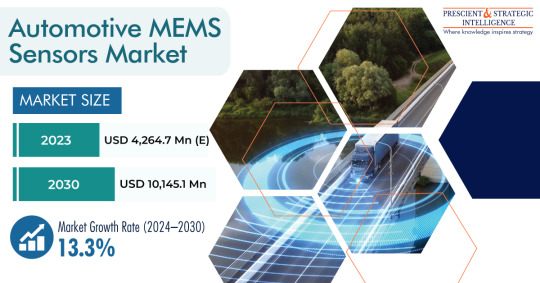
If you own a smartphone and internet connection in it, then you have all world stored in it. Technological evolution has been transforming our world. Mobile wallets are such technological evolution in the finance sector that has made easy transactions and mitigated the need to carry cash.
How Do Mobile Wallet Functions?
Users can easily access all the information on their bank cards stored on the mobile by entering a pin on the mobile app. The mobile app uses information transfer technology to facilitate interaction with mobile wallet’s ready-to-pay terminals. Besides storing credit or debit cards, mobile phone also stores loyalty cards, coupons, and tickets.
To keep your mobile wallet encashed you have to transfer money to it through a bank account, debit card, credit card, or link it directly. There are both types of mobile wallets, prepaid and post-paid wallets. The prepaid wallet is required to recharge to make payments. In post-paid wallets, they are directly linked with the bank account. Thus, each time the transactions you will make from a mobile wallet, the money will get deducted from the bank account.
In-Store Payments
Customers usually use mobile wallets for in-store payments, and it offers ease in making payments as compared to cash or physical credit cards. Mobile wallets listed with mobile service providers are accepted by numerous payment stores.
The major mobile wallets are Apple Pay, Samsung Pay, and Google Pay. These wallets are integrated into mobile devices. Users can also download them from the app stores.
Merchant Purchases
These mobile wallets offer numerous benefits to merchants. They facilitate a faster transaction, and hence mitigate the need for customers to stand in a long queue, and wait. Thus, it saves time for customers and provides them with a good experience. Moreover, the usage of mobile wallets reduces errors. Several times, while making cash payments, the cashier may enter the wrong amount. It may create a bad experience for customers by overcharging, and undercharging would cause revenue loss. Digital payments facilitate error-free transactions with integrated systems.
High Security
Digital wallets offer high security, they come with built-in authentication and encryption features. Hence, it ensures lesser risk for merchants to make big payments. Around 80% of online shoppers left their cart abandoned, without completing their payments in March 2021. Digital wallets are highly popular among millennials and Gen Z shoppers.
Therefore, the ease of convenience and the fast transaction facilitated by mobile wallets make them highly popular among millennials.
Automotive MEMS Sensors Market Revenue Forecast Report@ https://www.psmarketresearch.com/market-analysis/automotive-mems-sensor-market
0 notes
Text
Indonesia Micromobility Market is Led by the E-Moped Category
The Indonesia micromobility market will touch USD 19,888.5 million, powering at a 116.1% compound annual growth rate, by 2030.
This growth is because of the growing requirement for lessening urban traffic congestion, the rising need for first- and last-mile connectivity, and the convenience and low cost of such services for traveling.
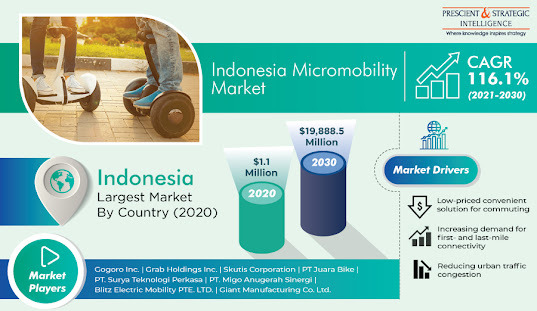
Moreover, the government is likely to seize the bike trend as a chance to make funding for sustainable mobility and make biking the favored approach of transport in the new-normal period. Several micromobility service providers that had ceased or decreased processes during the lockdown are now concentrating on enhancing their fleet sizes to fill the mounting demand.
Furthermore, micromobility offers different benefits than other modes of transport, for example, greater connectivity to public transportation hubs, reduced carbon footprint, and less reliance on personal vehicles. Also, these services assist in decreasing the issue of traffic jams on urban roads, as these automobiles are small and need less area for parking or on roads.
Additionally, the arrival of swappable batteries has boosted the fleet uptime significantly, while also decreasing the operating expenses, which has eventually taken the micromobility sector toward profitability.
In the past few years, the first-and last-mile category, based on model, was the larger contributor to the industry. Moreover, this category will propel at a faster compound annual growth rate during this decade. This is mainly because of the increasing acceptance of these services to subway entrances, reach offices, bus stops, schools, and public institutions.
With the increasing requirement to decrease urban traffic congestion and the surging need for first-and last-mile connectivity, the Indonesia micromobility industry will continue to progress in the coming years.
#Indonesia Micromobility Market#Urban Mobility#Innovation#Electric Scooters#Bike-Sharing Programs#Sustainability#Accessibility#Market Dynamics#Key Players#Regulatory Frameworks
0 notes
Text
Redefining Urban Transit: Exploring the Singapore Micromobility Market
With about 67% share in public and shared transportation, Singapore has a smart and sustainable mobility method. Only about 33% of the country’s transport are private modes for example car and motor bike.
Working toward a vision of a “car-lite” city, the government has recognized more than a few measures that make private cars somewhat costly and less attractive. A strict vehicle quota limits the car count. Road assessing surges the cost of private car use. And the tax system additionally imposes monetary burden on car proprietors. By doing so, Singapore is proactively fighting congestion, pollution, and car accidents.
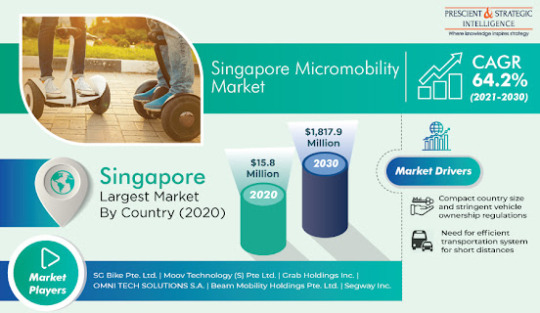
The Technocratic Management Pushes Non-Motorized Modes
The data-driven, technocratic government has an important role in shaping Singapore’s movement of the future in the long term. With the use of data and scenarios in a non-democratic but hard, transparent and effective way, the Singapore management is further driving maintainable transportation options concentrating on non-motorized modes. The public transportation system based on urban rail connects the city centre and the suburbs. It is continually expanded and enhanced.
Active mobility modes such as walking and cycling are underrepresented but pushed strategically, e.g. by building showers and lockers at mobility hubs such as bike stations. Roads are redesigned to be more pedestrian-oriented and cyclist-friendly. Recently added micro-mobility options such as e-scooters and kick scooters do further contribute to the reduction of individual motorized transport.
Autonomous Driving to Address Lack of Labor and Land
With its elderly populace sometimes called “silver tsunami,” the authorities are not banning cars completely. They are somewhat working toward a future on the basis of electric and autonomous cars. Many pilots for self-driving shuttles or buses are established. Autonomous driving can use roads more competently in a nation that is infamous for its shortage of land. Furthermore, self-driving buses are a solution to the lack of labor for functioning public transport.
MaaS with Public and Shared Transport as Core
Overall, the Singapore government is seeing a vision that is described as a continuous mobilityapproach. Singapore’s micromobility of the future will be a door-to-door, on-demand, multimodal service where shared, private, and public transport are all interconnected. It is the concept of MaaS that offers a mobility solution rather than only transport.
On the core it will be public and shared transport on the basis of smartphone apps that guarantee individual and tension-free first-and-last-mile connectivity. MaaS is an example for transporting the vision of seamless mobility to Singapore. With their Whim app, the Finnish startup plans to combine many transport modes, from bus to taxis, car sharing and bikes in just an app.
An important factor for micromobility in Singapore is the transportation being planned and monitored by a robust administration that collaborates with innovative startups in private-private partnerships.
Though the management offers anonymized traffic data, the startups bring the latest tech. This action is in robust contrast to many governments of the west whose incompetent administrations do still emphasis on widespread private car use and fail to reliably advance public and shared transportation.
Coming to a Conclusion
It is because of the increasing need for efficient transport systems for travelling short distances, the demand for micro mobility solutions in Singapore is on the rise. The total value of the industry will reach USD 1, 817.9 million by the end of this decade.
#Singapore Micromobility Market#Urban Transit#Innovation#Electric Scooters#Bike-Sharing Programs#Accessibility#Sustainability#Market Dynamics#Key Players#Regulatory Frameworks
0 notes
Text
What is LiDAR Technology?
LiDAR, short for Light Detection and Ranging, is a remote detection technology that powers laser light to calculate distances and make maps of the setting. It functions by releasing laser pulses and defining the elapsed time for them to reflect off matters and return to the sensor. This information is utilized to make 3D models of the environments. LiDAR technology discoveries applications in numerous industries, like geography, autonomous vehicles, meteorology, and geography.
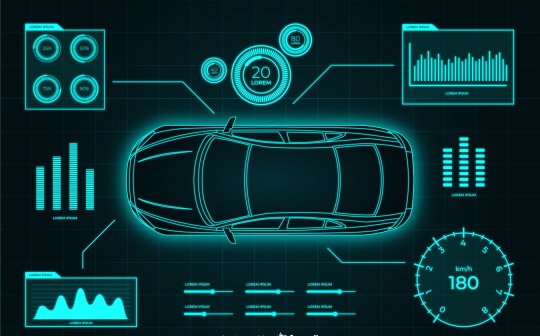
Originally, a concept in the 1970s and developed in the 1980s, LiDAR technology was huge, luxurious, and ineffective during its initial stages. However, with technological improvements resulting in compact devices, LiDAR has become a more available and essential technology in numerous sectors, including autonomous vehicles.
How is LiDAR Used in Cars?
In cars, Lidar technology supports the car's sensors and recognizes its surroundings. The
technology utilizes laser pulses to make 3D mappings of its atmosphere, such as objects like roads, buildings, and other vehicles. This data is then united with other information to guarantee safe navigation.
In effect, LiDAR tracks obstacles and cars to uphold safe distances. When utilizing this information, it is capable to recognize traffic signals, road signs, and road markings for real-time danger analysis. This technology is dominant in guaranteeing the safe and effective operation of autonomous vehicles.
Types of LiDAR Sensors
Mechanical LiDAR
Mechanical LiDAR utilizes a spinning mirror to sweep the laser beam, meting out the returning laser pulses to generate a 3D map of the surroundings. It is often utilized in surveying, mapping, and robotics and offers high-resolution information. However, it might be bulkier and less reliable than other LiDAR kinds, like solid-state.
Solid-State LiDAR
Solid-State LiDAR employs a solid-state laser and photodetector for emitting and detecting laser pulses, making it a compact and reliable LiDAR sensing solution. The laser emits light pulses that bounce off objects and return to the photodetector, which calculates the elapsed time for the light to travel there and back. This information is utilized to generate a 3D map of the environment processed by the LiDAR computer. This type of LiDAR is often utilized in autonomous vehicles, robotics, and applications requiring real-time, precise environmental data.
FMCW LiDAR
Frequency-Modulated Continuous-Wave (FMCW) LiDAR utilizes a radar-based technique for calculating the distance and velocity of objects utilizing light. Unlike pulsed LiDAR systems that release short, high-power laser pulses, FMCW LiDAR uses a constant waveform that progressively surges in frequency over time.
This makes an interferogram that is utilized to determine the velocity and range of objects in the field of view. FMCW LiDAR provides benefits like a longer measurement range, improved resistance to interference, reduced environmental effect, and the simultaneous measurement of several objects. It is extensively utilized in autonomous cars, industrial automation, and applications that need detailed data regarding the environment.
#Automotive LiDAR Market#Automotive LiDAR Market Size#Automotive LiDAR Market Demand#Automotive LiDAR Market Growth
0 notes
Text
Automotive Fuel Transfer Pumps Market: Trends, Innovations, and Global Growth Insights
The size of the automotive fuel transfer pumps market was USD 1,831 million in 2021, and it will grow at a rate of 5.8% in the years to come, to reach USD 3,041 million by 2030, according to a report of P&S Intelligence.
Electric-technology-based pumps led the industry in the recent past, due to their improved performance and higher efficiency in comparison to mechanical pumps.
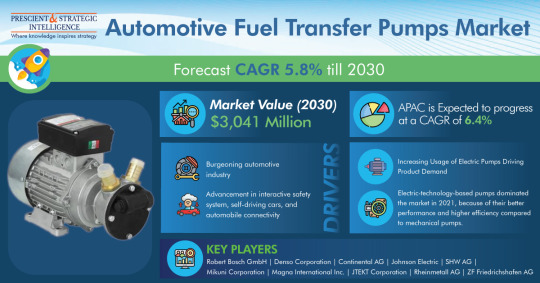
Furthermore, electric pumps offer numerous benefits, including improved pressure regulation, a lower wear and tear risk, and high strength. These devices are capable in operating at pressures between 30 and 40 pounds per square inch.
Vehicles featuring advanced injection systems make use of such pumps as these components are relatively safe and supply fuel to the engine proficiently, with a low loss of power. Electric vacuum fuel transfer pumps too help in the lessening of emissions of carbon dioxide from engines.
So, the acceptance of electricity-based injecting machines is relatively high, ensuing an increase in the price of an automobile. With the increasing awareness around the benefits, consumers are requiring automobiles fortified with electric pumps for transfer of gasoline.
The automobile fuel transfer pumps market was dominated by APAC and it will register the highest CAGR, of above 6.4%, in the years to come. The development of the automotive industry in China has grabbed the attention of numerous international automakers. Home to the major auto sector globally, the nation experiences a boom in the integration of components, transferring fuel from the tank to the engine.
Furthermore, the nation’s rapid embrace of hybrid vehicles has formed an increase in the sales of car, which bids a lot potential to auto component makers in the Peoples Republic.
#Automotive Fuel Transfer Pumps#Market Trends#Innovations#Global Growth Insights#Automotive Sector#Fuel Distribution#Market Players#Competitive Landscape#Pump Technology Advancements#Smart Fuel Transfer Systems
0 notes
Text
Smart Shipping Containers Market Will Touch USD 15,341.5 Million by 2030
The smart shipping container market was USD 3,971.2 million in 2022, and it will touch USD 15,341.5 million, propelling at a 18.4% compound annual growth rate, by 2030.
The growth of the industry is mainly attributed to the temperature regulation, enhance security measures, and real-time GPS tracking capabilities these containers offer. Moreover, because of the quick technological advancements in AI, IoT, big data analysis, and communication, the industry will further advance in the years to come.
Based on offering, the hardware category accounted for the largest smart shipping container market share, approximately 50%, and it will advance at the highest growth rate in coming years, because of the widespread adoption of various components for tracking and monitoring applications.

Based on technology, the industry is dominated by GPS due to its role in package monitoring and tracking.
Moreover, the quick implementation of the Bluetooth Low Energy (BLE) technology is because of the rising IoT devices implementation, which necessitates effective communication.
Additionally, the long-range wide area network (LoRa WAN) category will advance at the highest rate in the years to come. This is mainly because of the benefit of LoRa WAN as compared to other technologies, for instance, BLE and Wi-Fi.
Based on vertical, the food & beverage category will advance at the highest compound annual growth rate, of over 20%. This is attributed to the growing requirement for packaged food and perishable. Individuals are shifting their focus towards ready-to-eat food from homemade food, which is boosting the requirement for smart marine transportation solutions for edibles.
In 2022, the smart shipping containers industry is led by Europe, with a share of approximately 40%. This is because of the existence of numerous major industry players providing enhanced software and IoT sensors integrated hardware for effective analytics of data.
#Smart Shipping Container#Maritime Logistics#IoT Integration#Telematics#Supply Chain Efficiency#Global Market#Container Tracking#Remote Monitoring#Data Analytics#Industry 4.0#Innovation#Sustainable Shipping#Fleet Management#Real-time Visibility#Asset Security#Connectivity Solutions#Market Trends#Containerization#Emerging Technologies#Logistics Optimization
0 notes
Text
Powering the Waves: Small Marine Engines Market Insights
The small marine engines market value will reach USD 11,696.1 million by 2030 from USD 7,967.5 million in 2022, at a 4.9% CAGR. This growth can be credited to the growing demand for numerous kinds of boats utilized for recreational and relaxation events, and the growing coastal tourism for water activities including yachting, boating, and fishing.
Furthermore, the leaning toward the water-based leisure industry has been on the surge because of the increased expenditure on water-associated activities by a chunk of the populace. Also, the sense of better-quality mental health because of the quality time spent during water-based activities is a main factor for the booming boating demand, which, ultimately, quickens the outward and inward-placed engines of marine vessels.
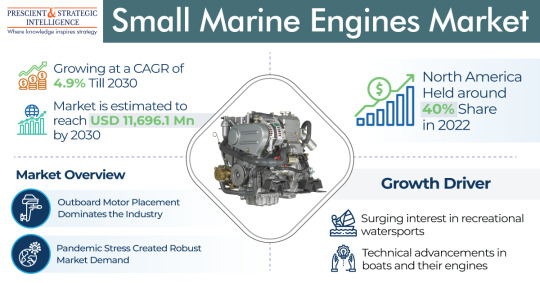
The mounted customer involvement in marine fun activities is offering worthwhile development opportunities for engine demand. In the past years, marine tourism and relaxation activities like yachting, power boating, and sailing, have experienced a significant surge, because of the growing disposable income of consumers. Moreover, rapid development in adventure tourism is helping water recreational activities.
As per a government-issued research article, above 50 million Americans went fishing, including artisanal fishing, commercial, and artisanal fishing, in 2021, which generated a profitable demand for outdoor or inner-placed motors in marine recreational vehicles. the recreational boats category, on the basis of the application segment, generated approximately USD 3.5 billion in revenue in 2022. And, a surge in demand for technically progressive fishing boats is projected to drive the development of the industry for engines and propulsion systems across the forecast period.
In 2022, the outboard motor category dominated the industry, and the category is also projected to advance at a CAGR of 5% in the coming years. This is mainly because of the technical advances, the requirement for outboard boats is projected to increase significantly in the coming few years.
#Small Marine Engines#Maritime Industry#Outboard Motors#Inboard Motors#Fuel Efficiency#Market Trends#Boating Enthusiasts#Lightweight Design#Global Market#Innovation#Recreational Boating#Commercial Vessels#Emerging Technologies#Environmental Impact#Regulatory Compliance#Power Output#Market Dynamics#Compact Engines#Coastal Tourism#Fishing Boats
0 notes
Text
Connected Journeys: Navigating Trends in the Intelligent Transportation System Market
The intelligent transportation system market will reach USD 102,617.3 million, propelling at a 10.2% CAGR, by 2030.
The growth of the industry is attributed to the rising adoption of advanced communication technologies, the growing requirement to enhance transportation safety and traffic flow, and the increasing population all over the world, which is boosting land vehicle sales.

In 2021, the services category held the largest revenue share, of approximately 50%, and it will remain the largest in the years to come. This is because of the requirement to increase the efficiency and connectivity of surface transportation networks, which needs the proper maintenance of intelligent transportation system equipment.
Advanced public transportation systems will observe the fastest growth in the years to come, with a 9% CAGR. This is credited to the increasing investment in real-time gathering and analysis of information for roadways, growing public–private partnerships, and the requirement to enhance the public transportation network’s operational effectiveness as well as passenger services.
In 2021, the advanced traffic management system held the largest intelligent transportation system market revenue share, and it will remain the largest in the years to come. This is because of their widespread adoption of roadways, the growing number of vehicles and commuters in cities, and rising concerns of people regarding decreasing the levels of pollution and traffic congestion.
Based on application, in 2021, the roadways category held the largest revenue share, and it will maintain its position in the coming years. This is because of rapid urbanization, increasing requirements for parking management, the rising rate of vehicle ownership, mounting congestion of traffic in smart cities, and the enormous number of companies that provide such solutions for terrestrial commuting.
APAC will observe the fastest growth, with approximately 8% CAGR, in the years to come. This is because of the emerging transportation infrastructure, rapid urbanization, increasing disposable income, rising industry of automobiles, and speedily developing infrastructure of roads in India and China.
Furthermore, in 2021, China accounted for the largest revenue share, and it will remain the largest in the years to come. This is attributed to the growing number of daily commuters in the nation, initiatives taken by the government to decrease emissions, and the increasing usage of new advanced technologies.
#intelligent transportation system#ITS technology#market trends#connected vehicles#smart cities#global market outlook#traffic management#market dynamics#infrastructure integration
0 notes
Text
Charging Ahead: Insights into the India Electric Car Market
The sales volume of the Indian electric car market is on track to hitting 376,000 units by 2030, rising from 37,792 units in 2022 at a 33.3% CAGR, as per P&S Intelligence.
This is primarily owing to the growing construction of manufacturing plants, increasing foreign direct investment, and strong push to improve the charging infrastructure.
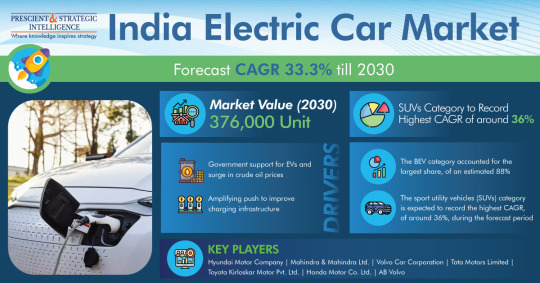
Due to Reducing Battery Prices, BEVs Outsell All Other Variants
With a share of about 88%, the BEV category held the largest share in 2022, and the same situation is predicted to sustain its position in the years to come. This is due to the growing preference for EVs over ICE vehicles, decreasing battery prices, and accessibility of several BEV models.
Based on product, the category of SUVs is predicted to register the highest growth rate, of about 36%, in the years to come. This is due to the increasing disposable income and growing requirement for premium cars.
Under the battery segment, the LFP category holds the largest market share, and it will continue to do so owing to the lower costs and longer life of LFP batteries.
Moreover, the >201 Ah battery capacity category accounts for the larger market share, and it is predicted to achieve the faster growth in the coming years. This is owing to the preference of consumers for cars with a longer range.
The category of personal users leads the market, and it is predicted to stay on this path till 230 because of the growing affordability of such cars and surging disposable income.
Most Sales of Electric Cars Take Place in Uttar Pradesh
Due to a large client base and a huge number of suppliers along the whole EV supply chain, Uttar Pradesh dominated the market in 2022. The Uttar Pradesh EV Manufacturing and Mobility Policy 2022 would help drive the sale of electric cars for both personal and commercial purposes.
Similarly, Maharashtra is expected to witness a significant growth rate during the forecast period. In July 2021, to boost the demand for EVs, the state government introduced a comprehensive policy, under which a USD 2,029.1 (INR 1.5 lakh) incentive is provided and consumers are also eligible for early-bird incentives.
#India electric car market#electric vehicles (EVs)#market analysis#sustainable transportation#market trends#EV adoption#market insights#industry players#market segmentation
0 notes
Text
Electrifying Commutes: Insights into the India Electric Scooters and Motorcycles Market
Electric scooters and motorcycles are two-wheeled vehicles that function only on electricity. They are not propelled by engines or orthodox fuels like gasoline, diesel, or CNG.
They utilizes electric propulsion and generally have a rechargeable battery. With the rising concerns on pollution and the resulting increase in the incidence of breathing issues among children and elderly alike, the Indian electric scooters and motorcycles market is projected to reach USD 6,161 million by 2030.

Safe, Suitable, and Simple to Use
Every method of travel has some type of danger involved with it. Still, if you compare an electric scooter or motorcycle to other more-fun methods of transport such as roller skating or cycling, they come out as, maybe, the better choice. Moreover, they need little to no talent to function—all you require is some balance They are a suitable choice for those who want to commute without any anxiety of danger.
Comparatively Eco-Friendly
A list of benefits to having an e-scooter or motorcycle is just not complete without addressing how environment-friendly they are. In the era of severe climate change, numerous individuals are finding methods to decrease their impact on the atmosphere, like shifting their modes of transportation.
Moreover, electric scooters and motorcycles are one of the greenest choices to date. Other than zero CO2 releases, electric scooters and motorcycles are also more energy-efficient. They are more effective at moving travelers— they take only a portion of the electricity compared to the amount of fuel a car burns to travel the same distance. Furthermore, technology for e-scooters has enhanced rapidly over the last two years, further advancing their eco-friendliness.
Helps In Skipping Traffic Jams
The motor and battery technologies utilized in electric scooters and motorcycles enable the rider to cover numerous kilometers with little effort. Moreover, the scooter itself is small in size, meaning riders can take benefit of dedicated lanes, which are traffic-free. This is particularly beneficial in areas where roads are jammed almost daily. Features
Basic features including an LED headlight and sleek design are being offered by numerous two-wheeler OEMs. On the other hand, several high-tech accompaniments include under-seat storage bins, a speed mode switch, USB ports, a smart remote key, cruise control, and a functional dashboard.
#India Electric Scooters and Motorcycles Market#India Electric Scooters and Motorcycles Market Size#India Electric Scooters and Motorcycles Market Share#India Electric Scooters and Motorcycles Market Trends#India Electric Scooters and Motorcycles Market Growth
0 notes
Text
Windshield Glass Saves You from Injuries During Accidents
Automotive glass is an important part of each and every vehicle. We will not find any vehicle, especially car without glass. And, there is no stopping the increasing demand of vehicles, because of the sharp increase in disposable income of the people. Due to an increase in the number of automobiles, there will also be a need for an automotive glass.

Laminated glass is the most used glass in vehicles. Consumers' requirement for safety, comfort and opulence makes it a prevalent choice amongst automakers, chiefly in high-end models.
Windshield is the Prime Application of an Automotive Glass
The automotive glass is largely used for making windshields, as they guarantee passengers’ safety. They act as a physical barrier between the inside and outside of the vehicle, shielding people from insects, flying objects, wind, rain, and other dangers.
In the event of an accident, a windscreen offers structural integrity to the automobile, which stops the roof from collapsing and passengers from being ejected out on to the road.
Smart Glass is Becoming Popular Day- by-Day
The industry for smart glass is on the rise, as this boosts comfort in high-end cars by automatically changing the tint to avert excessive sunlight from entering the car, and thus keeping it cooler. By changing from clear to opaque, there is also an unmatched privacy and safety, therefore attracting rich owners.
The tech also works in cooperation with sophisticated climate control systems to reduce the requirement for AC and surge energy competence, both of which advances the fuel economy.
APAC has a Considerable Demand for Automotive Glass
The APAC region has most of the population of the world, and thus there are the greatest number of vehicles on the road. This will only increase in the years to come as well, as the income of the people is on the rise. The region's automobile industry is flourishing with the growing production and sales in India and China.
#Automotive Glass Market#Automotive Glass Market Size#Automotive Glass Market Share#Automotive Glass Market Growth
0 notes
Text
Last Mile Delivery Market Will Reach USD 121.2 Billion by 2030
The last mile delivery market was USD 27.1 billion in 2022, and it will reach USD 121.2 billion, propelling at a 20.6% compound annual growth rate, by 2030.
The progression of the industry is mainly attributed to the surging utilization of omnichannel retailing, as well as the significant increase in internet penetration in emerging economies, including Thailand, Indonesia, and India.
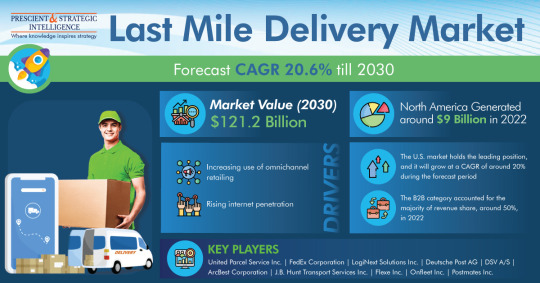
In 2022, the B2B category, based on service, dominated the industry, with approximately 50% share. This can be attributed to the fact that it provides numerous advantages to online retailers to attract B2B consumers, for instance, decreased delivery time, easy options of payment, doorstep delivery of heavy parts, heavy discounts on bulk buying, and decreased management expenses.
The B2C category will observe faster growth in the years to come. This is because of the shifting customer purchasing behavior, growing technical knowledge about the utilization of online platforms and smartphone apps, and, development in organized and omnichannel retailing.
Based on application, the e-commerce category will observe the fastest last mile delivery market growth, propelling at approximately 20% CAGR, in the years to come. This is because of the growing customer base, customers' expectations for fast and free shipping, demographic shift, and competitive pricing. Therefore, businesses are now focusing on overcoming the challenging delivery schedule of conventional logistics.
A major trend being observed in the industry is the implementation of autonomous vehicles for delivery. AI is a major technology for autonomous driving systems, as it is the only tech that allows real-time and reliable object recognition around automobiles. The implementation of autonomous vehicles will significantly decrease delivery expenses, therefore driving the e-commerce sector growth.
Moreover, the continent comprises developed nations, including Canada and the U.S., which are key industries for e-commerce and last-mile logistics. As per a report, consumers in the U.S. expended USD 10.7 billion on Cyber Monday and there were approximately 2.14 billion online buyers in 2022.
LAMEA will observe the highest growth, approximately 25%, in the years to come. This is mainly because of the rising disposable income of people in developing nations, for instance, Mexico and Brazil, the mounting number of food & grocery delivery start-ups and omnichannel retailing, and the mounting e-commerce sales.
#Last Mile Delivery Market#Last Mile Delivery Market Demand#Last Mile Delivery Market Growth#Last Mile Delivery Market Outlook
0 notes
Text
Southeast Asia E-Commerce in Automotive Aftermarket is Led by Thailand
The Southeast Asia e-commerce in automotive aftermarket was USD 3,819.8 million in 2022, and it will touch USD 9,184.6 million, growing at an 11.4% compound annual growth rate, by 2030.
The utilization of these platforms is surging due to the growing levels of internet utilization and digitalization across Southeast Asia, and the rising consciousness of consumers regarding the details of products and various other advantages of online shopping.

Furthermore, the progression is also assisted by the shift in the overall automotive aftermarket, as a result of the surging count of vehicles in operation and the rising occurrence of road accidents.
In 2022, the electrical parts category, based on component, accounted for the major share. With the increasing count of major manufacturers focusing on collaborations with leading sales platforms, the online sale of automotive electrical components will increase significantly in the years to come.
Moreover, the equipment category is likely to advance at the fastest rate in the Southeast Asia e-commerce in automotive aftermarket, of approximately 12%, in the years to come. This is because of the obtainability of various products through online platforms and the continuing trend of improving or upgrading different parts of automobile equipment.
Thailand is leading the industry, and it will remain leading, propelling at a significant rate, of almost 11%, in the years to come. This can be because of the large populace, speedy rate of urbanization, extensive automobile sector with numbers of online equipment manufacturers, and increasing disposable income in the nation.
Moreover, Malaysia will observe the highest growth in the industry, in the years to come. This can be primarily attributed to the mounting sales of vehicles in the country, which led to the surging progression of this industry in the nation.
In addition, the mounting utilization of digital media and the rising production of commercial automobiles in the nation will also assist in the momentous growth of the industry.
0 notes
Text
U.S. Electric Bus Market Research Report
0 notes